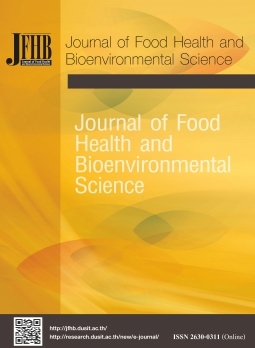Rice Bran Oil Emulsion Organogels as Fat Baking for Brownies
Keywords:
Organogel, Rice bran oil, Brownies, Baking fatAbstract
Rice bran oil emulsion organogels with different organogelators including triglyceride and policosanol are prepared and utilized as a bakery fat for making brownies. Texture profiles, percent of height gain, percent of weight loss, color, fatty acid composition, and sensory properties of the organogel brownies are investigated and compared with those of brownies made with rice bran oil and commercial margarine. The organogel brownies exhibit similar percent weight loss, percent height gain, hardness, gumminess and chewiness when compared to the commercial margarine brownies. Hardness, gumminess and chewiness in the organogel brownies are lower than rice bran oil brownie. The fatty acid compositions of both organogel brownies are similar to the rice bran oil brownie. Brownies prepared with the organogels exhibit considerable reduction in saturated fatty acid contents from 50.47% to 30.25% when compared with brownie prepared with commercial margarine. Policosanol and triglyceride organogels are potentially effective for producing nutritionally superior brownies with comparable quality attributes when compared to the margarine brownies.
References
Andy, N. (2004). Diet, nutrition and the prevention of chronic diseases. WHO technical report series 916. Report of a joint WHO/FSA expert consultation. International Journal of Epidemiology, 33(4), 914–915.
Amoah, C., Lim, J., Jeong, S., & Lee, S. (2017). Assessing the effectiveness of wax-based sunflower oil oleogels in cakes as a shortening replacer. LWT-Food Sci Technol, 86, 430-437.
Aranceta, J. & Pérez-Rodrigo, C. (2012). Recommended dietary reference intakes, nutritional goals and dietary guidelines for fat and fatty acids: A systematic review. BJN, 107(S2), S8-S22.
Campbell, G.M., & Mougeot, E. (1999). Creation and characterisation of aerated food products. Trends Food Sci Technol, 10(9), 283-296.
Cheong, L.Z., Tan, C.P., Long, K., Idris, N.A., Yusoff, M.S.A., & Lai, O.M. (2011). Baking performance of palm diacylglycerol bakery fats and sensory evaluation of baked products. Eur J Lipid Sci Technol., 113(2), 253-261.
Demirkesen, I., & Mert, B. (2020). Recent developments of oleogel utilizations in bakery products. Critical reviews in food science and nutrition, 60(14), 2460-2479.
Devi, A., & Khatkar, B. (2016). Physicochemical, rheological and functional properties of fats and oils in relation to cookie quality: A review. JFST., 53(10), 3633-3641.
Hartnett, D.I., & Thalheimer, W.G. (1979). Use of oil in baked products-Part II: Sweet goods and cakes. Journal of the American Oil Chemists' Society, 56(12), 948-952.
Hwang, H.S., Singh, M., Bakota, E.L., Winkler-Moser, J.K., Kim, S., & Liu, S.X. (2013). Margarine from organogels of plant wax and soybean oil. Journal of the American Oil Chemists' Society, 90(11), 1705-1712.
Hwang, H.S., Singh, M., & Lee, S. (2016). Properties of cookies made with natural wax–vegetable oil organogels. J Food Sci., 81(5), C1045-C1054.
Kaewkool, P., Kittiratanapiboon, K., Aryusuk, K., & Krisnangkura, K. (2009). Micro-reactor for transesterification of plant seed oils. Eur J Lipid Sci Technol., 111(5), 474-480.
Karaoğlu, M.M., & Kotancilar, H.G. (2009). Quality and textural behaviour of par-baked and rebaked cake during prolonged storage. Int J Food Sci Tech., 44(1), 93-99.
Marangoni, A.G. (2012). Organogels: An alternative edible oil-structuring method. Journal of the American Oil Chemists' Society, 89(5), 749-780.
Matsakidou, A., Blekas, G., & Paraskevopoulou, A. (2010). Aroma and physical characteristics of cakes prepared by replacing margarine with extra virgin olive oil. LWT-Food Sci Technol., 43(6), 949-957.
Micha, R., & Mozaffarian, D. (2010). Saturated fat and cardiometabolic risk factors, coronary heart disease, stroke, and diabetes: A fresh look at the evidence. Lipids, 45(10), 893-905.
Mozaffarian, D., & Ludwig, D.S. (2015). The 2015 US dietary guidelines: lifting the ban on total dietary fat. Jama, 313(24), 2421-2422.
Onacik-Gür, S., & Żbikowska, A. (2019). Effect of high-oleic rapeseed oil oleogels on the quality of short-dough biscuits and fat migration. Journal of Food Science and Technology, 57(10), 1-10.
Patel, A.R., Rajarethinem, P.S., Grędowska, A., Turhan, O., Lesaffer, A., De Vos, W.H., & Dewettinck, K. (2014). Edible applications of shellac oleogels: Spreads, chocolate paste and cakes. Food & function, 5(4), 645-652.
Pehlivanoglu, H., Ozulku, G., Yildirim, R.M., Demirci, M., Toker, O.S., & Sagdic, O. (2018). Investigating the usage of unsaturated fatty acid-rich and low-calorie oleogels as a shortening mimetics in cake. J Food Process Pres, 42(6), e13621.
Pyler, E.J., & Gorton, L.A. (2008). Baking science & technology: (Volume I): Fundamentals & ingredients. Kansas, USA.: Sosland Publishing.
Rodriguez-Leyva, D., Bassett, C.M., McCullough, R., & Pierce, G.N. (2010). The cardiovascular effects of flaxseed and its omega-3 fatty acid, alpha-linolenic acid. CJC, 26(9), 489-496.
Rodríguez-García, J., Laguna, L., Puig, A., Salvador, A., & Hernando, I. (2013). Effect of fat replacement by inulin on textural and structural properties of short dough biscuits. Food Bioprocess Tech., 6(10), 2739-2750.
Stortz, T.A., Zetzl, A.K., Barbut, S., Cattaruzza, A., & Marangoni, A.G. (2012). Edible oleogels in food products to help maximize health benefits and improve nutritional profiles. Lipid Technol., 24(7), 151-154.
Uruakpa, F.O., & Fleischer, A.M. (2016). Sensory and nutritional attributes of black bean brownies. AJFSN, 3(3), 27-36.
Weerawatanakorn, M., Meerod, K., Wongwaiwech, D., & Ho, C.T. (2019). Policosanols: Chemistry, occurrence, and health effects. Current Pharmacology Reports, 5(3), 131-149.
Willett, S.A., & Akoh, C.C. (2019). Physicochemical characterization of yellow cake prepared with structured lipid oleogels. Journal of Food Science, 84(6), 1390-1399.
Zhou, J., Faubion, J.M., & Walker, C.E. (2011). Evaluation of different types of fats for use in high-ratio layer cakes. LWT-Food Sci Technol., 44(8), 1802-1808.
Downloads
Published
How to Cite
Issue
Section
License

This work is licensed under a Creative Commons Attribution-NonCommercial-NoDerivatives 4.0 International License.








